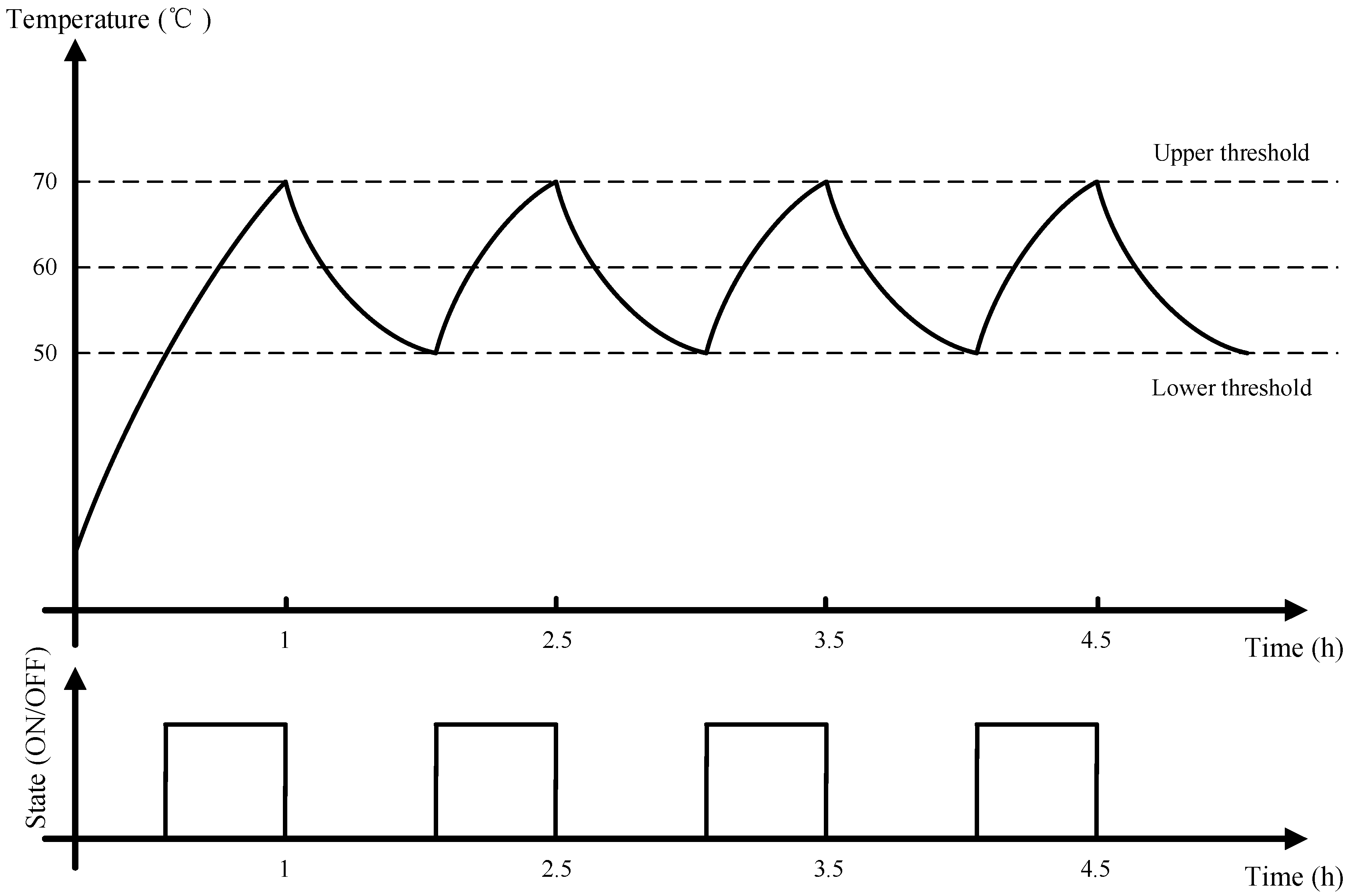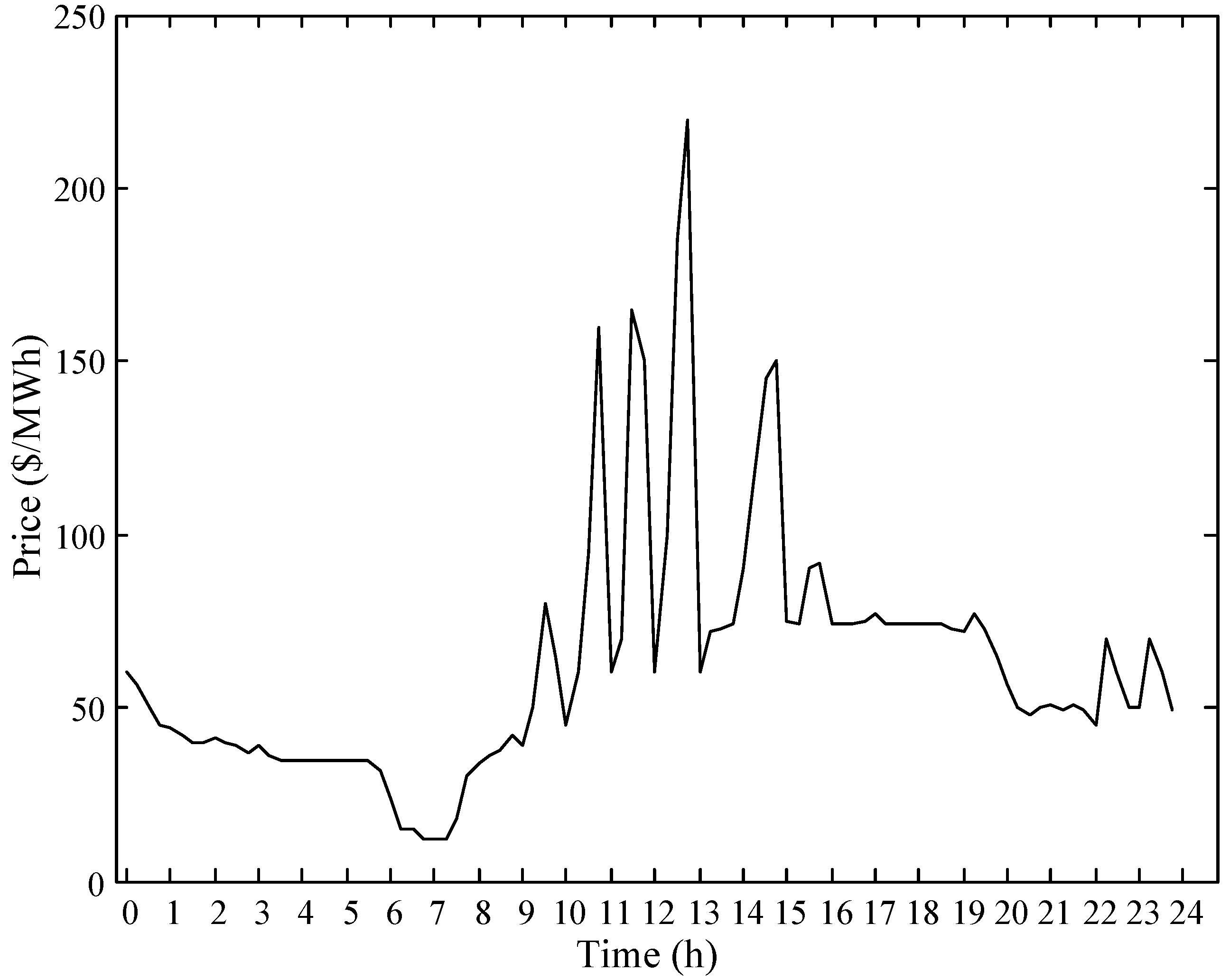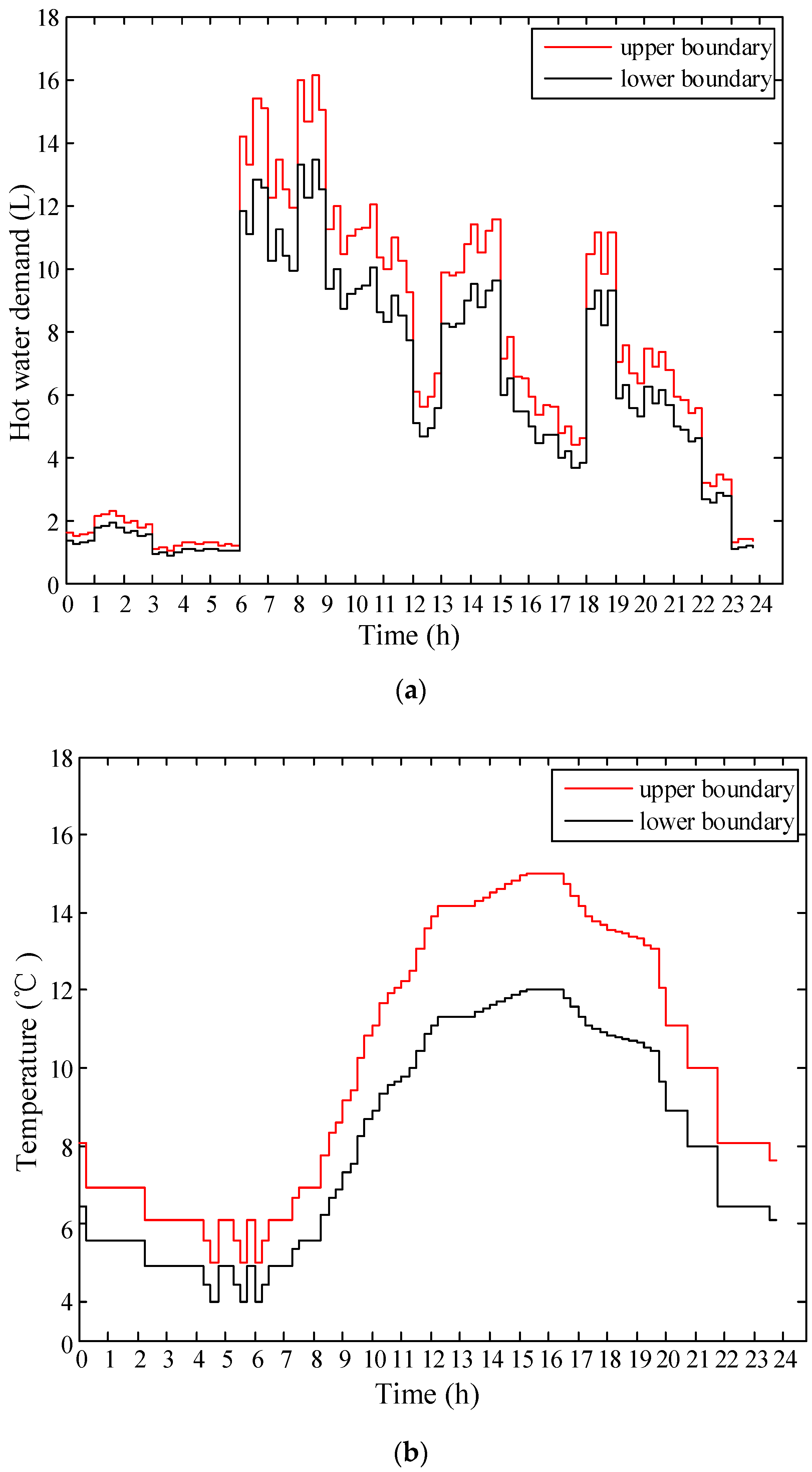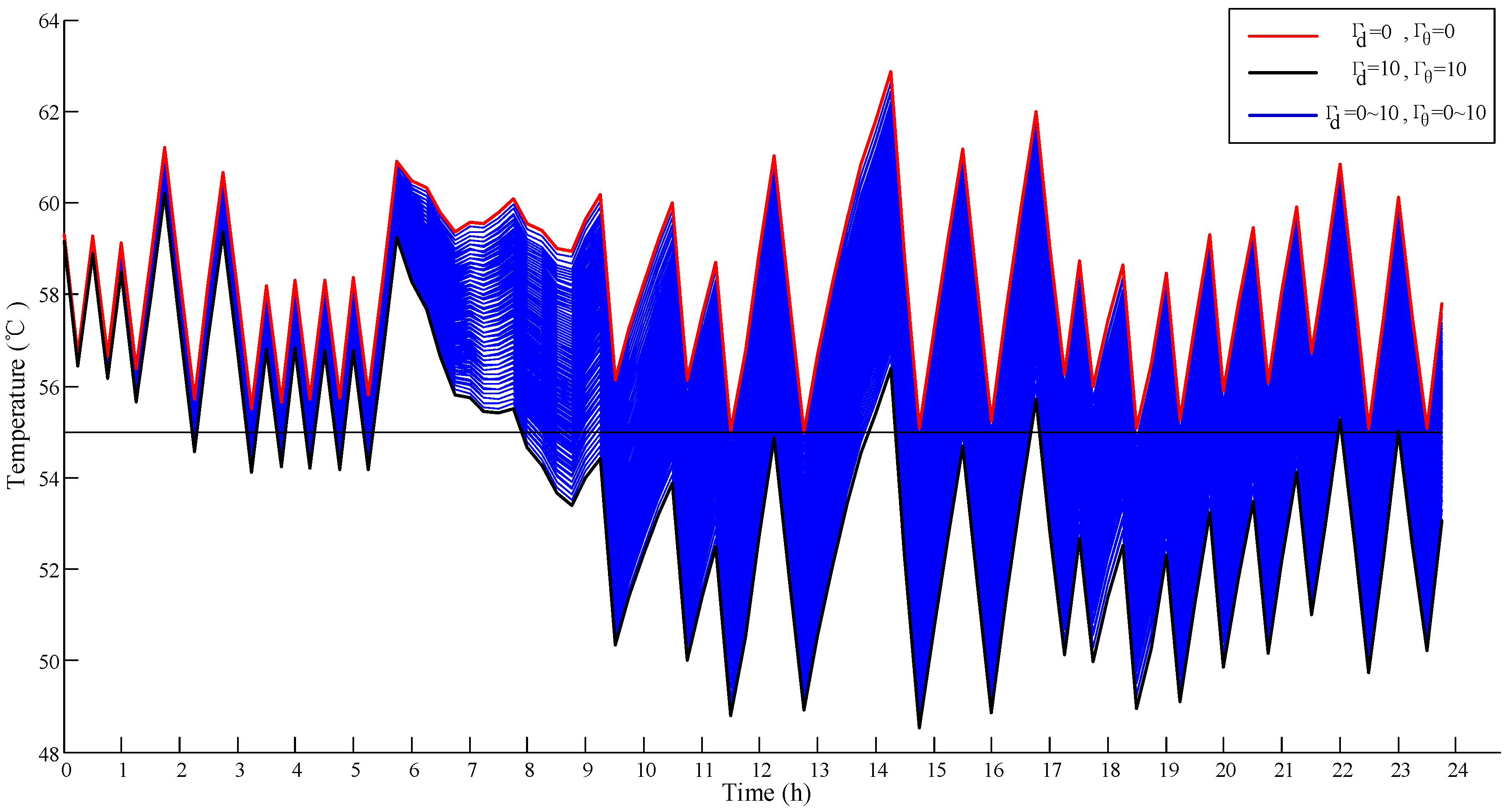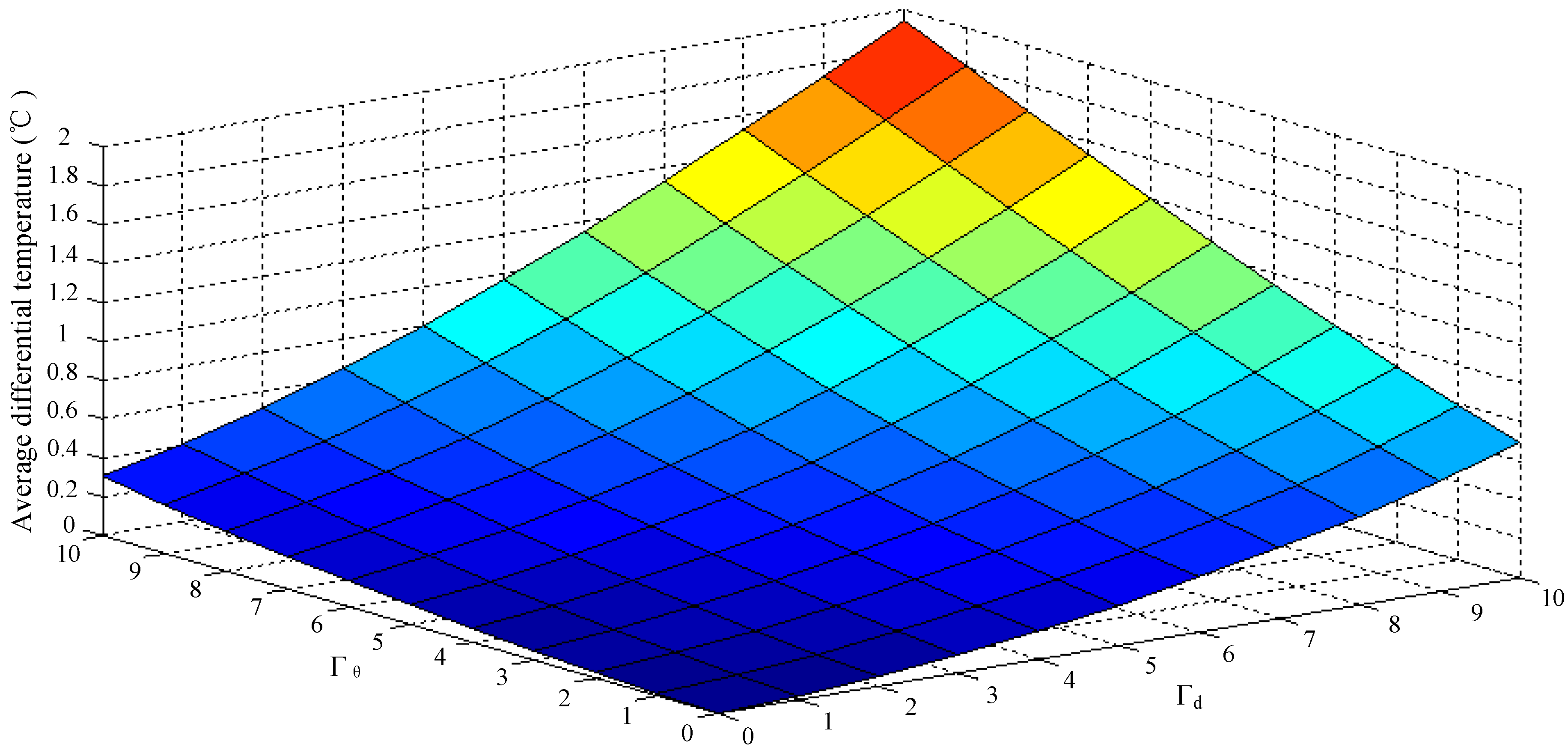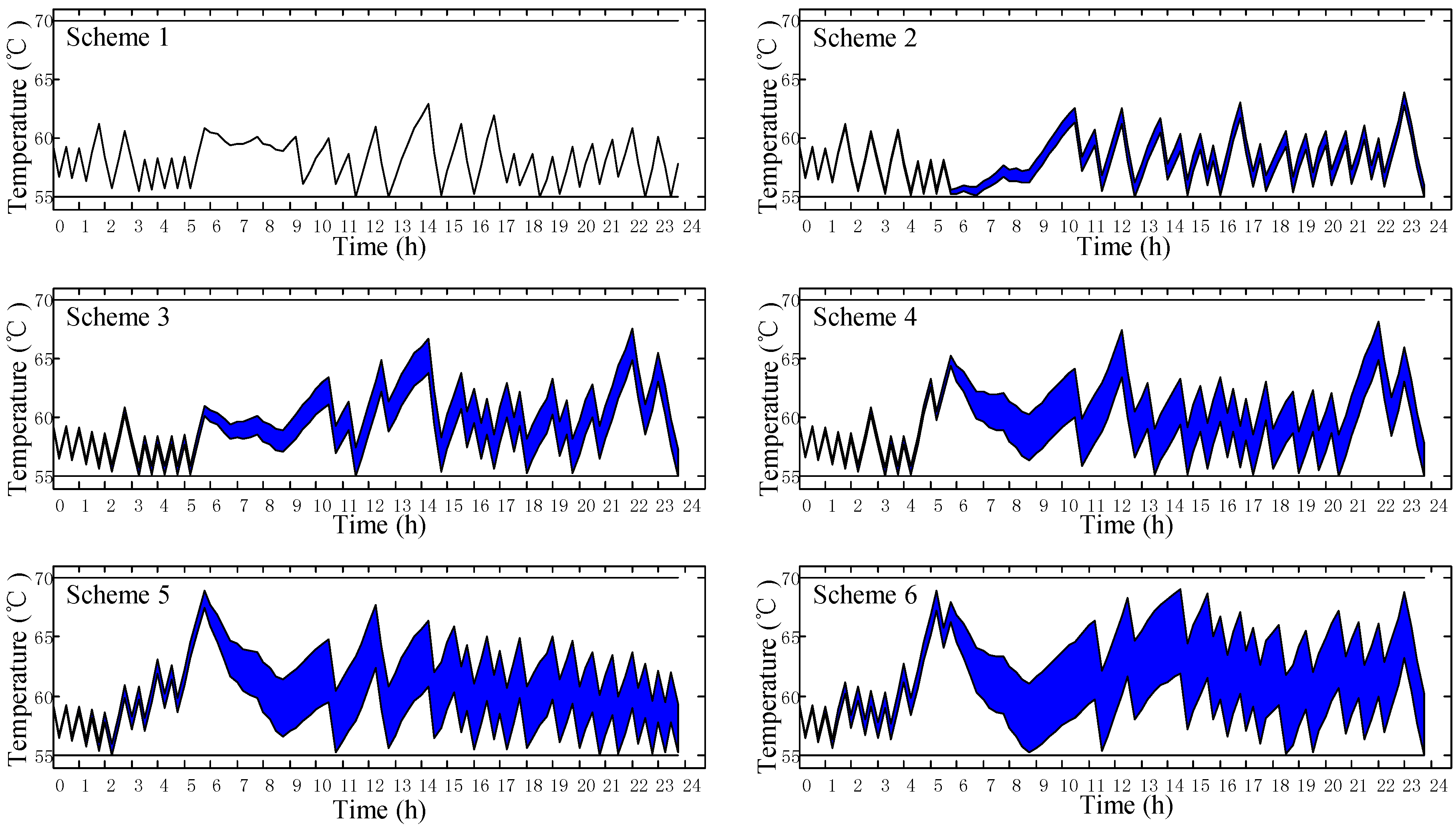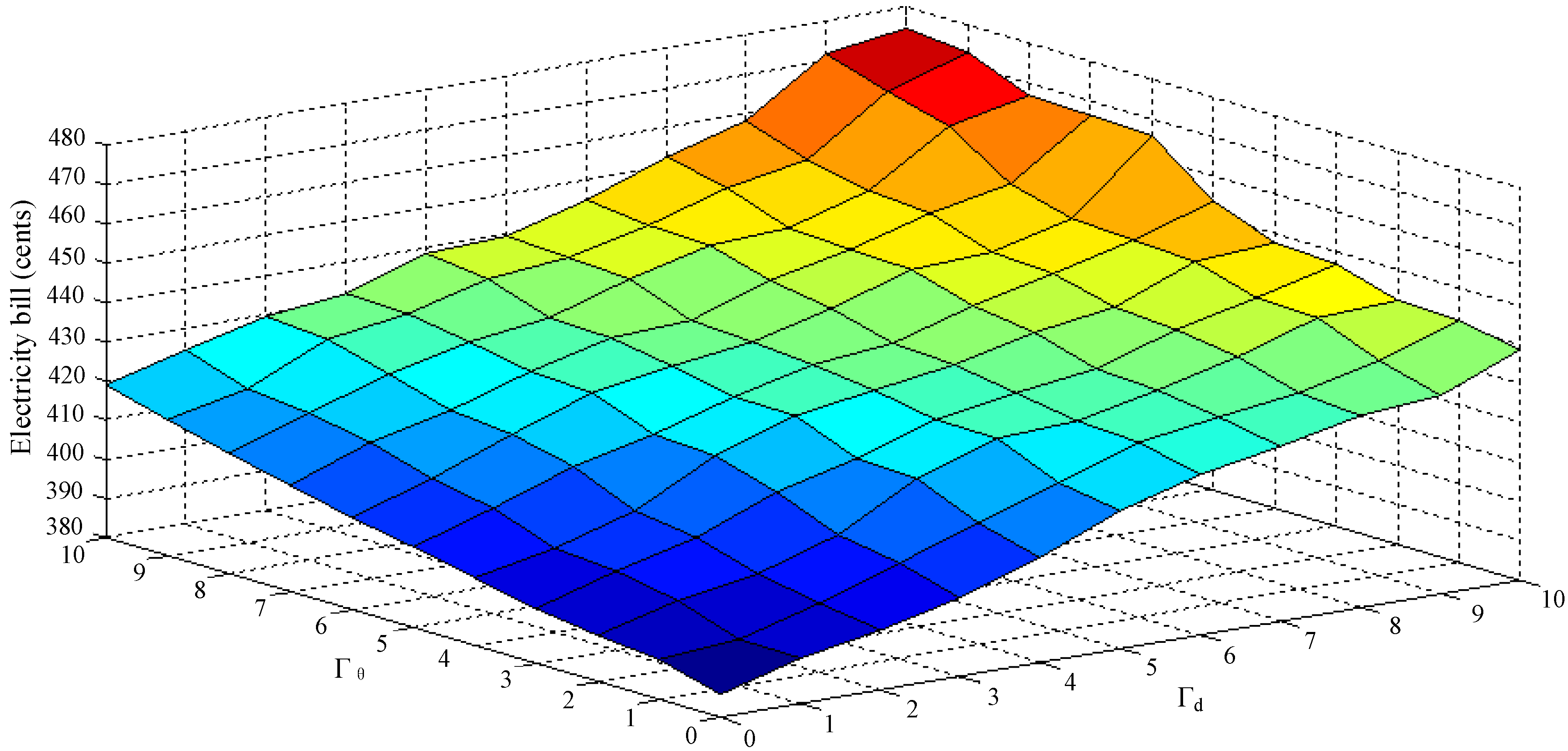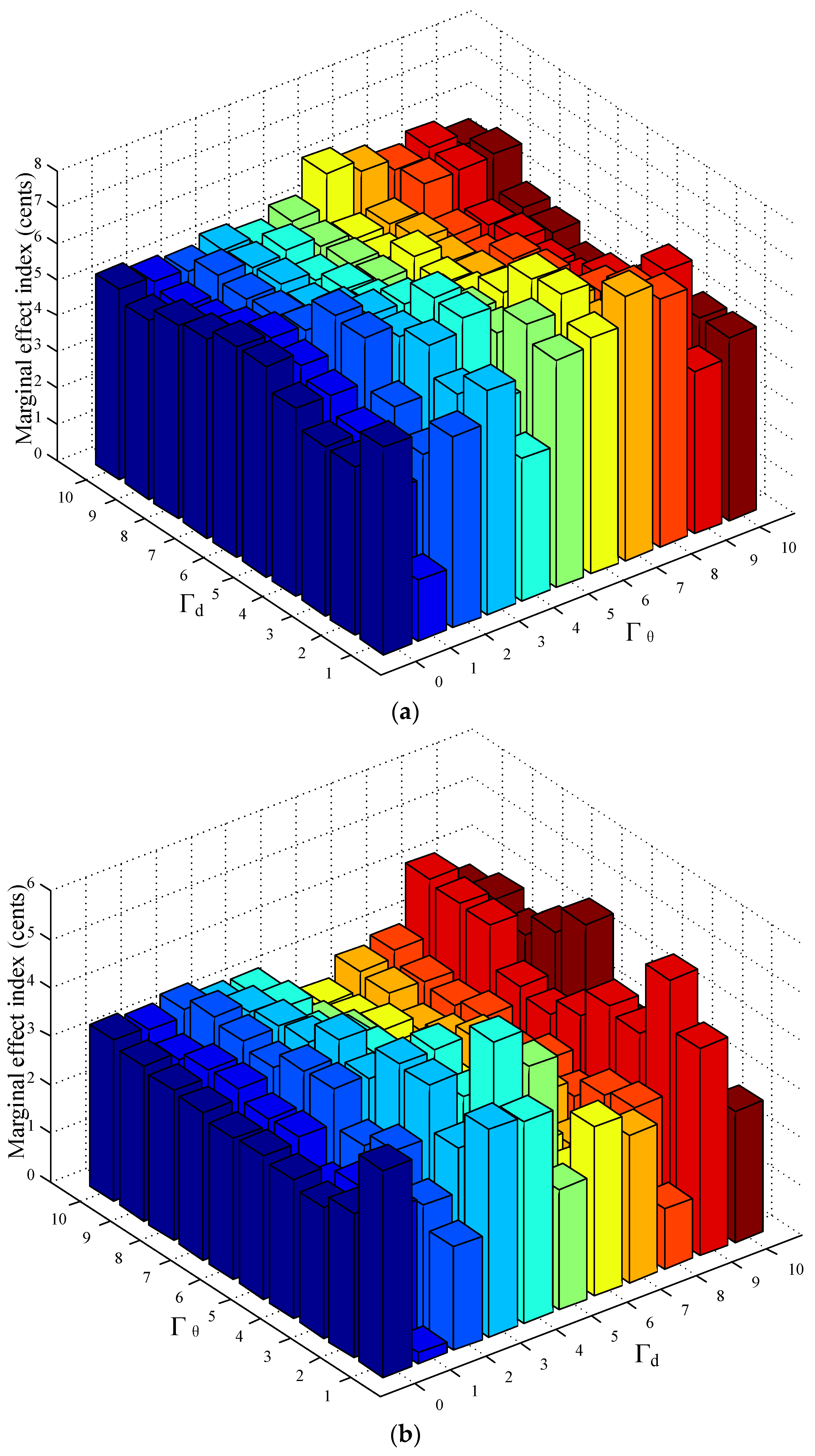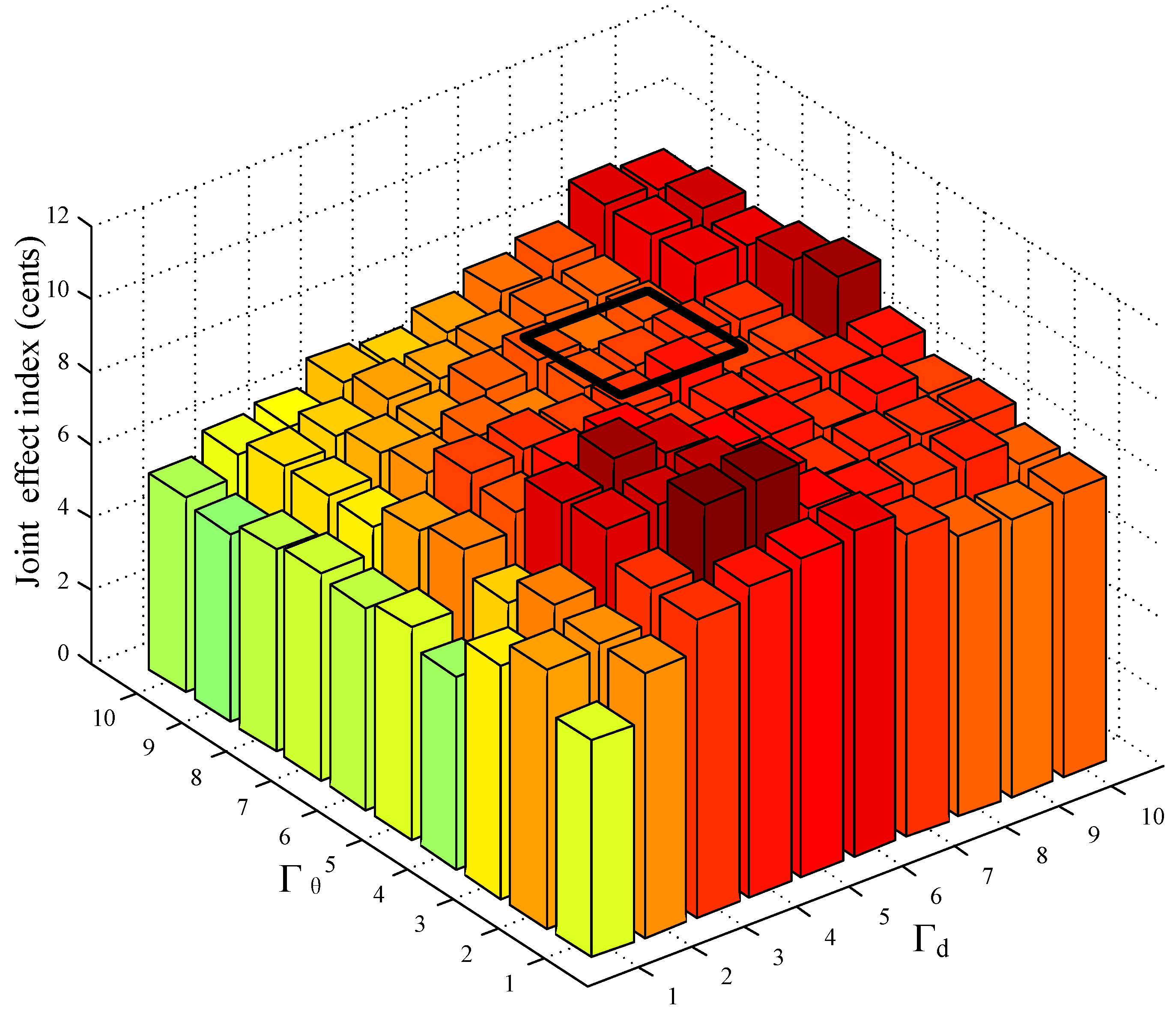1. Introduction
With the emergence of smart grids and the increase of electricity demand, home energy management system (HEMS) is attracting increasing attention as an important part of demand side of management. HEMS is able to improve the implementation of the distributed energy resource and shift the demand to off-peak periods [
1]. At present, monetary incentives are the major driving force for residential consumers to participate in household load management. Flexible pricing schemes, such as critical peak pricing (CPP), time-of-use (TOU), and real-time pricing (RTP), are designed by utilities to encourage users to actively respond to demand side management [
2,
3].
Responding to the various pricing schemes, load scheduling plays an essential role in HEMS [
4,
5], which optimizes working schedules for household appliances to reduce the electricity bill and improves the power consumption efficiency while satisfying the consumers’ comfort constraints [
6]. Domestic electric water heaters (DEWH) are considered as well suited for demand side management, because of their high nominal power ratings combined with large thermal buffer capacities [
7].
In addition, DEWH load accounts for a considerable share of the whole household load. In USA and Japan, DEWH load contributes as much as 17% and 27% to the total household electrical energy consumption [
8,
9]. Therefore, the scheduling strategies for DEWH load are vital for HEMS to help consumers to automatically obtain optimal DEWH load schedules. With such background, several valuable works have been done on DEWH load scheduling.
There are rich scheduling algorithms that are aimed to minimize the electricity payment under different rate structures, and various strategies for DEWH scheduling have been studied extensively. In [
10], three consumer strategies were studied to schedule DEWHs under dynamic pricing, including timed power interruption, price-sensitive thermostat, and double period setback timer. Furthermore, a series of scenarios with different set points of water temperature in tank (between 120 and 140 °F) were analyzed to study the relevance of electricity cost to set points. In [
11], DEWH load was deemed as an example of thermostatically controlled household loads, and scheduled through a linear-sequential-optimization-enhanced, multi-loop algorithm. A transactive control strategy was utilized to schedule the DEWH load iteratively according to the sorted day-ahead forecast price. Though the proposed optimization strategy is indeed simple, the created schedules are not necessarily cost-efficient. Given this deficiency, Reference [
12] put forward a traversal-and-pruning (TP) algorithm to address the optimization problem of DEWH load scheduling. To handle the curse of dimensionality of the solution tree, a novel method named “Inferior Pruning” was proposed to traverse to the superior node’s sub-nodes. Simulation results indicated that approximately 20% energy cost was reduced with the same comfort level as that of the reference method.
However, in the above literatures, all of the relevant parameter values in household load scheduling are considered to be forecast completely accurately, which is not the real case in practice. Generally, forecast errors are inevitable for some parameters such as weather conditions, consumer behaviors, etc. [
13]. With such a background, studying methods to tackle the uncertain parameters caused by forecast inaccuracy is of great significance for household load scheduling. In [
14,
15], a two-stage stochastic optimization approach was introduced to tackle the uncertain household load scheduling. The decision variables were separated into two types of sub-variables named here-and-now variables, which are asked for decision-making at a given time and wait-and-see variables that can be determined later when enough information is available. In [
16,
17], fuzzy programming was introduced to tackle the uncertain optimization in HEMS, in which uncertain parameters, like electricity prices and outdoor temperature, were described by fuzzy parameters.
In comparison to traditional methodologies for uncertain optimization problems, such as stochastic programming and fuzzy programming, interval analysis (a kind of set-theoretical and non-probabilistic method) only requires the bounds of the magnitude of uncertainties, not necessarily requiring the specific probabilistic distribution densities. As less uncertainty knowledge is needed, interval number is suitable for describing the uncertain parameters in DEWH load scheduling with limited uncertainty knowledge. Therefore, in this paper, the uncertain parameters in DEWH are modeled as interval numbers, and the uncertainties are divided into different robust levels. Then, the DEWH load scheduling problem is rebuilt under different robust levels and its constraints are transformed into an equivalent form for solving. Simulation results show that the proposed method can provide consumers with the robust schedules with different robust levels. In addition, the trade-off between the electricity bill and the conservatism level can be made to offer a diversity of options for consumers.
This paper is organized as follows. The original DEWH load scheduling problem is presented in
Section 2. The rebuilt DEWH load scheduling problem under different robust levels is provided in
Section 3. Simulation results are shown in
Section 4.This paper is summarized in
Section 5.
2. The Domestic Electric Water Heaters (DEWH) Load Scheduling Problem
The DEWH load scheduling problem has been summarized into a mathematical programming problem, of which the objective is to minimize the consumers’ electricity bill under flexible tariff structure and the constraints are about device limits and thermal comfort [
18,
19,
20,
21]. The scheduling problem is built on the thermal dynamic model of a DEWH, which describes the process of the heating and coasting of water in the tank.
Figure 1 shows the water temperature curve in a DEWH tank.
As shown in
Figure 1, there are two operation states for a DEWH, being “switch on” state and “standby” state. When the water temperature in tank drops to the lower threshold, then the water heater is switched on to recover the water temperature into comfort zone; when the water temperature in tank reaches the upper threshold, the water heater becomes standby. The thermal dynamic model is used to describe the behavior of a DEWH [
11]. When only the standby heat loss is considered, there is
where
denotes the temperature of hot water in tank at the time
;
denotes the ambient temperature/cold water inlet temperature at the time
;
represents the on/off state of DEWH over period
(1-on; 0-off ); and, the constants
Q,
R and
C are equivalent thermal parameters, which represent the electric water heater capacity, thermal resistance, and thermal capacitance, respectively.
Moreover, when the hot water demand is considered, Equation (1) is modified as
where
is just the
calculated in (1),
is the water demand at the time
, and
M is the mass of water in the tank. Combining the two equations, one united expression is given to simplify the thermal model as follows:
Equation (3) calculates the water temperature in tank in each step straightforwardly. It lays the foundation for the DEWH load scheduling. The detail proof process refers to
Appendix A.
However, this temperature-driven running mode might be not cost-efficient under the flexible pricing schemes. The time-varying electricity price enable the DEWH load to operate more flexibly and cost-efficiently, motivating the DEWH to preheat the water in tank in the low electricity price periods and reduce the load in the peak-price periods [
7].
So, when considering the time-varying prices, the DEWH load scheduling is modeled as follows. The objective function is to minimize the next 24-h total electricity expense and the constraints limit the water temperature under the consumers’ setting zone. The states of the DEWH are the decision variables in the model, which should be solved for consumers as guiding schedules for the following day. Mathematically, the DEWH load scheduling can be formulated as [
12]:
subjected to
where
N is the number of all the time steps over the scheduling horizon and
denotes the rated power of DEWH;
represents the time-varying prices in the
nth time step.
Hence, the DEWH load scheduling problem can be summarized into a linear optimization problem, the optimal solution of the problem is exactly the DEWH load schedule that the consumers require.
4. Simulation Results
In this paper, a day-ahead DEWH load scheduling (from 0 a.m. to 12 p.m.) is considered. The length of each time step, Δ
t, is set as 15 min. Chosen from the 2012 American Society of Heating, Refrigerating, and Air-Conditioning Engineers (ASHRAE,) Hand-book [
27], the specific parameters in the thermal dynamic model of DEWH are listed in
Table 1. The daily real-time prices are assumed to be known. The RTP values refer to [
16], as shown in
Figure 2.
As mentioned above, the uncertain water demand and ambient temperature are transformed into intervals, and the consumers quantify the optimistic degree of the uncertainties by means of setting the robust levels
and
. In this paper, the forecast maximum intervals of hot water demand and ambient temperature for the next day are plotted in
Figure 3, respectively, referring to [
23]. As for the maximum values of robust levels,
and
are both assigned as ten, which denotes that the uncertainties of water demand and ambient temperature are divided into 10 different levels. At the same time, we should think over the deterministic situation where one of the robust levels is equal to zero or both of them are zero. Therefore, the number of the robust level pairs (
,
) is 11 times 11, being 121 in total.
4.1. The Sscheduling Problem under Different Robust Levels
When consumers believe that the forecast values are highly convincing so that the uncertainties can be ignored, the robust level pair takes the value of (0, 0). Thus, the water demand and ambient temperature lose the characteristic of uncertainty and become real numbers. In this case, the optimal schedule is deemed to be solved without uncertainties, called “deterministic schedule” for convenience. However, in practice, the uncertainties of hot water demand and ambient temperature actually give rise to huge fluctuations of the water temperature in tank, so it is possible that the huge fluctuations may make the water temperature out of the threshold when applying the deterministic schedule.
Therefore, it is necessary to make a sensitivity analysis to figure out the influence of these uncertainties. As stated in
Section 3.1, the robust parameters somehow indicate the different uncertainty levels of the parameters, therefore that are used here to generate the various scenarios that are used to verify the deterministic schedule. Specifically, the robust parameters are both set from zero to ten, creating 121 scenarios of different water demand and ambient temperature values. While still applying the deterministic schedule, the actual hot water temperatures in the 121 scenarios are shown in
Figure 4.
In
Figure 4, the red line represents the upper boundary of the actual water temperature in tank. However, the 121 different sorts of blue lines represent different lower boundaries, while robust level pairs are set from (0, 0) to (10, 10). Specially, the special line colored black is exactly the lower boundary of water temperature under the highest level of uncertainties, where the values of two robust levels both are 10. As shown in
Figure 4, from 8 a.m. to 12 p.m., most blue lines are lower than the consumers’ lower threshold line, which means that the thermal comfort constraints are violated. This fact demonstrates that the deterministic schedule cannot satisfy the consumers’ thermal comfort requirement under most levels of uncertainties and in most times of a day. The minimum water temperature is down to 48.53 °C, and the difference between the minimum value and the threshold reaches 6.47 °C. Such a great temperature deviation is unacceptable for common people.
To evaluate the degrees of the violation of the constraints under crossed impact of the two parameters, average differences of water temperature between the lower boundaries and threshold are shown in
Figure 5. Obviously, with the uncertainty levels of the two parameters increasing, the average temperature difference rises more and more seriously. Also, it is easy to find that the robust level,
, brings much more dangerous degree of violation than the robust level
. That is to say, the hot water demand will create more negative drop on the water temperature than the ambient temperature. In one word, the aforementioned the DEWH load scheduling model with different robust levels is indispensable for the consumers to obtain robust solutions.
4.2. Robust Schedules with Different Robust Levels
In this part, the load schedules with different robust levels and the corresponding electricity payment are presented. The various robust schemes are solved by CPLEX under difference levels of uncertainties. Six typical robust schemes, where the robust level pairs (
,
) are set as (0, 0), (2, 2), (2, 8), (8, 2), (8, 8), and (10, 10), respectively, are extracted from the 121 robust schemes as representatives and are shown in
Figure 6. It can be seen that all of the typical schemes strictly satisfy the users’ comfort constraints under corresponding uncertain levels. It demonstrates the great robustness of the schemes while facing different levels of uncertainties. As the uncertain levels increasing, the interval of hot water temperature becomes wider.
Observing the six schemes in
Figure 6 and the RTP prices in
Figure 1, the schemes indeed pre-heat the water during the period that the RTP prices are generally low and shut down the DEWH when the prices are extremely high. When compared with the six schemes, it can be found that the working periods with high level of uncertainties are much longer to maintain the temperature in the comfort zone.
Figure 7 gives the values of electricity bill under different robust levels settings. As shown in
Figure 7, to meet the constraints under higher level of uncertainties, the users have to pay more. It proof that the users can also gain the completely robust and comfortable schemes at the cost of higher electricity bill.
4.3. The Trade-Off Between the Conservatism of Uncertainties and the Economy
From the above analysis, it is obvious that the bill for consumers will be expensive when they are willing to cover high degree of conservatism of uncertainties. Consequently, acquiring one robust schedule that has not only the best economy, but also the highest level of robustness is a troublesome problem. First of all, to tackle this problem, we predefine two types of scenarios: scenario A is taking the conservatism of only one of the uncertain parameters into account, while scenario B considers the conservatism of both uncertain parameters.
In scenario A, the marginal effect indexes (MEI) for the robust level
and
are defined in Equations (21) and (22), respectively, reflecting the average incremental cost per level of the single uncertain parameter (the water demand or ambient temperature). When calculating the MEI for one robust level, the other robust level should be assumed as a constant. The marginal effect index bars for the robust level
and
are plotted in
Figure 8.
By means of the MEI, consumers can choose a trade-off robust schedule that contains the most conservatism at the lowest cost when one of the robust level is clear. For example, assuming that the robust level
is clearly equal to be nine, but the other robust level
may be any integer in the interval [
5,
8]. This assumption is possible, meaning that consumers have complete confidence in the 9th level of uncertainty of the hot water demand, and have hesitation between 5th and 8th level of the uncertainty of ambient temperature. Form the red bars shown in
Figure 8b, the MEI has the lowest value when
is equal to 6, indicating that it is the best balance between the conservatism of ambient temperature and the economy. Therefore, the robust schedules under the robust parameter pair (6, 9) is recommended to consumers.
Similarly, the joint effect index (JEI) is defined in Equation (23) to handle the Scenario B. Differing from the single robust level situation in the Scenario A, the root mean square (RMS) of the two robust levels
and
stands for the per level of the joint impact caused by two uncertain parameters. Just like the MEI, the joint effect index plotted in
Figure 9 offers the consumers the most balanced schedule as well. Due to the change of the two robust levels, the bars are only colored for the height of the bars.
Taking another instance for demonstration, we assume that the two robust level
and
are a integer which is ranged in the interval [
6,
8]. The black frame in
Figure 9 boxes the area where the consumers are not sure about both of the two robust parameters from 6th to 8th level. In this area, the robust level pair (7, 8) has the lowest value and should be offered for consumers.
5. Conclusions
This paper proposes a robust optimization strategy for domestic electric water load scheduling to tackle the uncertainties in the hot water demand and ambient temperature. Specifically, this paper adopts the interval numbers to describe the uncertainties and divided the uncertainties into different robust levels in order to control the degree of the conservatism. By bringing the intervals and robust levels into the constraints, the optimization problem is rebuilt to consider the parameter uncertainties. Furthermore, for easy solving, the constraints that contain the uncertainties are transformed into equivalent deterministic ones. A sensitivity analysis is developed, showing that the infeasibility of the deterministic schedule under various levels of uncertainties.
Simulation results verify that the consumers can obtain various completely robust schemes, which strictly meet the constraints under different levels of uncertainties. Meanwhile, this paper defines the marginal effect index (MEI) and joint effect index (JEI) to evaluate the trade-off between the electricity bill and conservatism of uncertainties. The simulation results indicate that, with the help of the MEI and JEI, the optimal schedule that covers the highest degree of conservatism at the lowest cost is recommended to users.
The proposed robust optimization strategy can be used in home energy management system (HEMS) to help consumers to arrange the DEWH load while facing the uncertainties. Also, it could be applied to more appliances in the future. Moreover, this paper only deals with day-ahead scheduling. The real-time scheduling using the proposed method remains to be studied.
